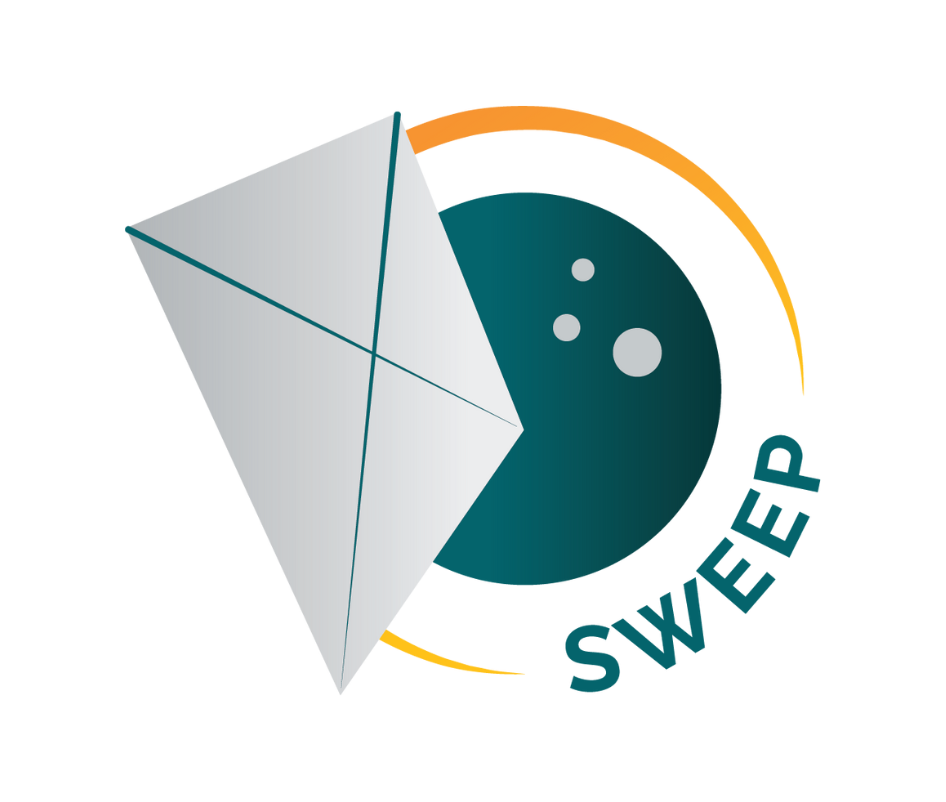About
In 2019, the European Space Agency commissioned the world’s first active debris removal mission, ClearSpace-1, to remove one piece of debris. However, with the huge number of debris objects, individual missions picking up individual pieces of debris is not the solution. The cost of that many launches and their impact on the climate demand a more sustainable approach; one that removes multiple debris targets during a single mission. However, manoeuvring towards and between debris objects and removing them from their orbit requires a lot of energy – in other words, when using traditional forms of spacecraft propulsion it requires too much fuel.
The SWEEP project therefore takes an innovative approach by considering propellantless solar sails as propulsion method. A solar sail is a large, very thin, mirror-like membrane that reflects solar photons and thereby induces an acceleration on the spacecraft. As such, a solar sail lets a satellite “ride on sunlight the way sailboats ride on the wind”. To demonstrate whether solar sails can indeed provide a way to clean up multiple debris targets during a single mission, the team of the SWEEP project will answer the central question: “Is it possible to use a solar sail to move towards a piece of debris, deorbit it, travel to the next object, and repeat the cycle again and again?”.
Numerous challenges currently prevent answering this central question, particularly 1) the non-existence of an accurate dynamical model that describes the motion of a satellite with a solar sail around the Earth, 2) the fact that manoeuvring around the Earth with a solar sail implies solving a huge-dimensional and highly constrained trajectory-optimisation problem, and 3) that, with the huge number of debris objects, knowing which pieces of debris to remove in which order requires solving a so-far unexplored travelling salesman problem. The central objective of SWEEP therefore is to:
Create state-of-the-art models and numerical tools to examine the solar-sail orbital dynamics around Earth to demonstrate solar sailing as unmatched propulsion method for many-target debris removal
Some examples of the models and tools that will be created include a new force model for a solar sail in orbit around Earth that will be derived from actual flight data (e.g., data from NASA’s upcoming ACS3 solar-sail mission) and a tool that will exploit machine-learning techniques to solve the travelling salesman problem.
Importance
The SWEEP project aims to contribute to a cleaner space environment. Its outcomes are welcomed by space agencies, companies, and key academic players (see the partners involved below). Indeed, ESA’s Space Debris Office believes that “The usage of solar sails to facilitate the removal of multiple space-debris targets has the potential to impact the long-term evolution of the space-debris environment in a cost-effective manner.” The ultimate deliverable of the SWEEP project is a joint proposal for a technology demonstration mission as proof-of-concept of the innovative ideas explored throughout the SWEEP project.
Project Status
The project, funded by an NWO Vidi Grant in the Applied and Engineering Sciences Domain, started in January 2023 and will run for five years until January 2028. Two PhD researchers have been recruited and funded through the Vidi grant. They started their exciting research projects on “Redefining the Solar-Sail Orbital Dynamics Around Earth” and “Solar-Sail Trajectory Optimisation for Active Space Debris Removal” in March 2023. In May 2023, the User Committee of the SWEEP project convened for the first time. At the start of 2024, the team will expand when several collaborative MSc student will join the project for their MSc thesis works.

